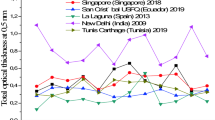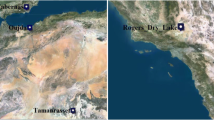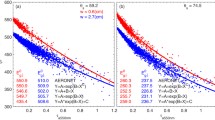Abstract
Our calculation program based on the Iqbal formula integrates the solar irradiance during all the hours of the day, taking into account the position of the sun, the latitude of the studied site and total optical thicknesses (TOT) extracted from the AErosol RObotic NETwork database AERONET, to find the attenuation of the solar irradiance by the atmosphere. The cloudless atmosphere reduces the incident solar irradiance in the equatorial zone, characterized by a more regular meteorology, by about 30%. In temperate zones, the attenuation is variable, up to 50% in regions subject to desert dust and anthropogenic emissions (Delhi case). We can also observe weak attenuations of about 22% due to the low aerosol load (La_Laguna case).
Access provided by Autonomous University of Puebla. Download conference paper PDF
Similar content being viewed by others
Keywords
1 Introduction
The use of incident solar energy on the surface of a given site requires the precise determination of the amount of annual radiation that actually reaches it after penetration of the corresponding atmospheric column. The introduction of the total optical thickness of the seasonal cycle in the absence of clouds makes it possible to obtain an accurate estimate of this solar radiation.
The sun is the basis of all energies. It produces the necessary heat and light for the life of beings on Earth. Due to the high energy demand, it is necessary to study all aspects of the exploitation of the solar radiation, in particular, the study of the atmosphere and its effects, and thus the choice of a suitable place for the realization of solar farms to anticipate and avoid natural or industrial constraints. Models have been created to predict solar radiations on Earth’s surface [1]. However, they remain approximate, with much uncertainty because each zone has its meteorological and particle characteristics, which makes the components and concentrations of the atmosphere different.
Total Solar Irradiance (TSI) is affected by the 11-year solar cycle. Using satellite measurements, Gueymard synthesizes 42 years of TSIs to obtain the mean value of the solar constant of radiation equal to 1361 W/m2 [2], which is adopted by the International Astronomical Union (IAU) [3]. In Delhi, between April and June 2003, there was an abundance of desert aerosols where the Aerosol Optical Depth AOD at 500 nm was 1.17 ± 0.65 [4].
2 Site and Materials
The optical thickness (TOT) used is measured by the solar photometers that exist in the AERONET database [5], which also allow the determination of the particle size distribution [6]. TOT(λ) is the sum of the contributions of Rayleigh interactions τRay, aerosols τaer and gas τgaz (Table 1):
From Fig. 1, we find that the two equatorial sites are characterized by an identical seasonal TOT of around 0.6, as for the different sites of the temperate zone, TOT values are low for La_Laguna—because human activities are few and the site is very far from the sources of industrial pollution—and high for New_Delhi due to human activity emissions and desert aerosols.
3 Solar Irradiance
The Solar irradiance on the Earth’s surface is related to the geographical latitude φ, the eccentricity factor of the earth’s orbit E0, the solar declination δ, the solar constant Isc, and the hour angle of the sunrise ωs [7]; the extraterrestrial irradiance on a horizontal surface during the day from sunrise to sunset is given by the formula:
3.1 Atmospheric Attenuation of Solar Irradiance
Due to aerosol extinction, molecular scattering (or Rayleigh) and gas absorption, solar irradiance is attenuated. This attenuation may be expressed with the Bouguer law on the wavelength λ by
where \(m_{\text{air}}\) is the relative air mass expressed by [8].
To determine the monthly attenuation of solar irradiance by the atmosphere, we calculate the solar irradiance at the top of atmosphere I0 and we insert the TOT to obtain the atmospheric attenuation (TE) Fig. 2.
For Singapore, the attenuation by the atmosphere remains almost constant. For ICIP_Mbita, there is more attenuation during spring and summer. La_Laguna registers high attenuation during August and July. The influence of urban aerosols produced by the unceasing Human activities in New Delhi makes the atmospheric attenuation of the solar irradiance very large.
4 Aerosol Particle Size Distribution
The monthly average of the aerosol particle size distribution (Fig. 3) shows low volumes for both fine and coarse modes, throughout the year, for ICIP_Mbita and Singapore. La_Laguna registers a noticeable rise in particle concentration for the coarse mode during August, and very low for the fine mode. For New_Delhi, the concentrations are high for both modes, especially the coarse mode from April to August.
5 Conclusions
The monthly solar radiation in the equatorial region is almost constant, while in the temperate zone, the atmospheric attenuation is stronger in summer and autumn because of the desert aerosol. The highest attenuation of about 50% is recorded in Delhi, where the desert aerosol is combined with the urban one, attributed to human activity.
References
Christian, G.: Critical analysis and performance assessment of clear sky solar irradiance models using theoretical and measured data. Sol. Energy 51(2), 121–138 (1993)
Christian, G.: A reevaluation of the solar constant based on a 42-year total solar irradiance time series and a reconciliation of spaceborne observations. Sol. Energy 168, 2–9 (2018)
IAU.: Resolution B3 on Recommended Nominal Conversion Constants for Selected Solar and Planetary Properties. International Astronomical Union, Paris, France (2015)
Sachchidanand, S., Shambhu, N., Ramesh, K., Risal, S.: Aerosols over Delhi during pre-monsoon months: characteristics and effects on surface radiation forcing. Geophys. Res. Lett. 32, L13808 (2005)
Aerosol RObotic NETwork. http://aeronet.gsfc.nasa.gov
B.N. Holben, T.F. Eck, I. Slutsker, A. Smirnov, A. Sinyuk, J. Schafer, D. Giles, O. Dubovik: AERONET’s version 2.0 quality assurance criteria. In: Asia-Pacific Remote Sensing Symposium on International Society for Optics and Photonics, 64080Q-64080Q (2006)
Muhammad, I.: An Introduction to solar Radiation. Academic Press, Toronto (1983)
Kasten, F., Young, A.T.: Revised optical air mass and approximation formula. Appl. Opt. 28, 4735–4738 (1989)
Author information
Authors and Affiliations
Corresponding author
Editor information
Editors and Affiliations
Rights and permissions
Copyright information
© 2021 The Editor(s) (if applicable) and The Author(s), under exclusive license to Springer Nature Switzerland AG
About this paper
Cite this paper
Ben-tayeb, A., Diouri, M., Steli, H. (2021). Comparison of the Atmospheric Attenuation of the Equatorial and Temperate Zones. In: Ksibi, M., et al. Recent Advances in Environmental Science from the Euro-Mediterranean and Surrounding Regions (2nd Edition). EMCEI 2019. Environmental Science and Engineering(). Springer, Cham. https://doi.org/10.1007/978-3-030-51210-1_143
Download citation
DOI: https://doi.org/10.1007/978-3-030-51210-1_143
Published:
Publisher Name: Springer, Cham
Print ISBN: 978-3-030-51209-5
Online ISBN: 978-3-030-51210-1
eBook Packages: Earth and Environmental ScienceEarth and Environmental Science (R0)







